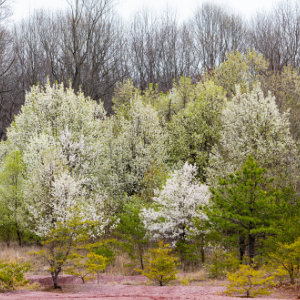Callery Pear
Callery pear (Pyrus calleryana) trees are often seen growing along urban streets and in residential landscapes and are prized for their showy white flowers that bloom in abundance each spring. However, these non-native invasive trees can spread prolifically into natural spaces and outcompete native trees, shrubs, and other vegetation, replacing food sources and habitat with less desirable alternatives for pollinators and wildlife.
- Credit: Paul Cooper, “Binghamton New York Bus Station”, CC BY-NC 2.0
- Credit: Chesapeake Bay Program, “Invasive callery pear in Anne Arundel County, Maryland”, CC BY-NC 2.0
- Credit: slgckgc, “Callery Pear Blossoms”, CC BY 2.0
Identification

Credit: Payton Chung, “callery pears”, CC BY 2.0
The Callery pear, also known as Bradford pear, is an ornamental tree species that grows up to 40 feet in height. It has 2-3” shiny green leaves with slightly toothed-margins along the leaf edge. The overall shape of the Callery pear tree is described as tear-dropped or spade-like. Its rough textured bark is gray-brown in color and exhibits shallow furrows and scaly ridges with age. It produces abundant, small, and malodorous white flowers which appear in spring before the leaves emerge. Its 1” diameter fruits are green to brown in color and are often consumed by birds. Although it provides food for wildlife, berries from Callery pear have poor nutrition value, compared to fruits from native vegetation. Callery pears are often planted around commercial spaces and residential properties. It frequently escapes into nearby areas where it can easily establish in roadsides, rights-of-way, and old fields.
Invasive Species Spotlight: Callery Pear – Credit: New York – New Jersey Trail Conference
Callery pear may be confused with other trees that produce white flowers in the spring including:
Additional information on how to identify Callery pear can be found online.
Ecological Threat
Invasive Callery (Bradford) Pear – Credit: Oklahoma State University Natural Resources Extension
Video Note: Mexican plum (as mentioned in the video) is not native to Pennsylvania, and therefore is not recommended for planting in our state.
Once established, Callery pear trees form dense thickets that push out native plants which are unable to tolerate shade or compete for water, soil, and space. A single Callery pear tree can spread rapidly by seed and vegetative means, forming a sizeable patch within several years.
Control and Removal
If Callery pear is present on your property, consider removal and management options. The following resources provide valuable information and tips.
Invasive Callery Pear Treatment – Credit: Clemson University – PSA
Other management tips can be found at: Penn State Extension
Other management tips can be found at:
Plant Native Alternatives
*This list is not comprehensive, but rather provides a sampling of species available for purchase from retailers located in Pennsylvania and/or surrounding states. All native plant distribution maps (below) are provided by the Biota of North America Program.
- Credit: Dan Mullen, “Allegheny Serviceberry”, CC BY-NC-ND 2.0
Allegheny Serviceberry (Amelanchier laevis)
Allegheny serviceberry grows best in average to medium soils that receive good drainage and in areas that receive full sun to part shade. This short stature tree grows 15-25 feet in height, making it suitable to plant underneath utility lines.
- Credit: Gary Liu, “Eastern redbud @ ground of sculpture”, CC BY-NC-ND 2.0
Eastern Redbud (Cercis canadensis)
Eastern redbud prefers to grow in soils with an average to medium amount of moisture and that are well-draining. It grows best in areas that receive full sun to part shade, and because Eastern redbud grows to a height of 20-30 feet, it’s a good choice for planting underneath utility lines.
- Credit: Photo by David J. Stang, CC BY-SA 4.0, via Wikimedia Commons
Green Hawthorn (Crataegus viridis)
Green hawthorn is best suited for planting in average, dry to medium, and well-drained soils. It prefers to be in spaces that receive full sun; however, it will tolerate a light amount of shade as well as drought. This tree can grow to a height of 25-35 feet, making it compatible for planting underneath utility lines.
Learn More and Take Action
Why are Native Plants Important?
Learn more about the importance of planting native plants by reviewing the following resources. And remember, planting even one native plant on your property is a tremendous benefit to wildlife and the environment!
Doug Tallamy Explains, “Why Native Plants?”
Credit: Catherine Zimmerman

Landscaping with Native Plants in Pennsylvania
Credit: PA Department of Conservation and Natural Resources
Professor Doug Tallamy on Sustainable Landscaping
Credit: University of Delaware
Discover Native Plants.
Learn what plants are native to your area by using the National Wildlife Federation’s Native Plant Finder or the Audubon’s Native Plants Database. Both programs are easy to use - just type in your zip code and a list of native plants is provided to you.
Record Invasive Species Findings with iMapInvasives.
If you find invasive plants and animals in natural areas such as parks, forests, and meadows, please report them to iMapInvasives, an online tool used by natural resource professionals and citizen scientists to record locations of invasive species The iMapInvasives program is useful in understanding species distributions statewide and is used by land managers to prioritize locations to conduct treatment efforts. In Pennsylvania, the iMapInvasives program is administered by the Western Pennsylvania Conservancy and the Pennsylvania Natural Heritage Program and is financially supported by the Great Lakes Restoration Initiative. At the national level, iMapInvasives is administered by NatureServe.
A free registered user account is needed in order to contribute and view data in iMapInvasives. Register here.
How to create a presence record in iMapInvasives online (video)
Connect with Our Experts
Please direct any questions or comments regarding this species profile to Amy Jewitt, Invasive Species Coordinator, or Mary Walsh, Aquatic Zoology Coordinator.














